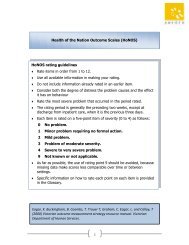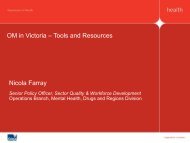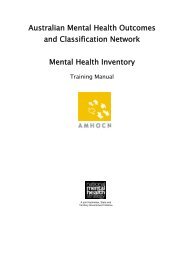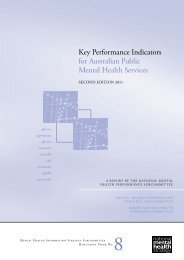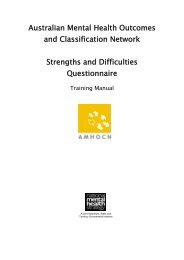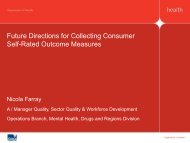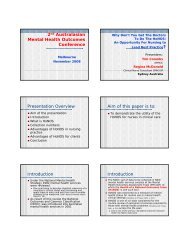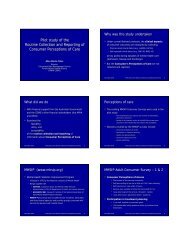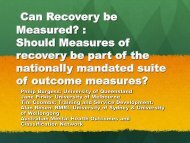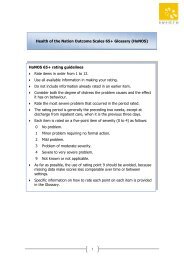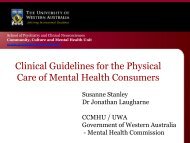Lucy Laphen - Australian Mental Health Outcomes and ...
Lucy Laphen - Australian Mental Health Outcomes and ...
Lucy Laphen - Australian Mental Health Outcomes and ...
You also want an ePaper? Increase the reach of your titles
YUMPU automatically turns print PDFs into web optimized ePapers that Google loves.
HoNOSCA RATING SCALESAlways refer to the full HoNOSCA Glossary in your Clinician’s Reference when making the ratings.Complete the ratings at Admission into all mental health service settings only after the first comprehensive clinical assessmenthas been completed.Only use code 7 if you are definitely unable to make the rating.HoNOSCA RATING SCALESAlways refer to the full HoNOSCA Glossary in your Clinician’s Reference when making the ratings.Complete the ratings at Admission into all mental health service settings only after the first comprehensive clinical assessmenthas been completed.Only use code 7 if you are definitely unable to make the rating.1. Problems with disruptive, antisocial or aggressive behaviour 0 1 2 3 4 72. Problems with overactivity, attention or concentration 0 1 2 3 4 73. Non-accidental self-injury 0 1 2 3 4 74. Problems with alcohol, substance or solvent misuse 0 1 2 3 4 7BEHAVIOUr1. Problems with disruptive, antisocial or aggressive behaviour 0 1 2 3 4 72. Problems with overactivity, attention or concentration 0 1 2 3 4 73. Non-accidental self- injury 0 1 2 3 4 74. Problems with alcohol, substance or solvent misuse 0 1 2 3 4 7Inpatientcommunity5. Problems with scholastic or language skills 0 1 2 3 4 7impairment5. Problems with scholastic or language skills 0 1 2 3 4 76. Physical illness or disability problems 0 1 2 3 4 77. Problems associated with hallucinations, delusions or abnormal perceptions 0 1 2 3 4 78. Problems with non-organic somatic symptoms 0 1 2 3 4 79. Problems with emotional <strong>and</strong> related symptoms 0 1 2 3 4 7SYMPTOMs6. Physical illness or disability problems 0 1 2 3 4 77. Problems associated with hallucinations, delusions or abnormal perceptions 0 1 2 3 4 78. Problems with non-organic somatic symptoms 0 1 2 3 4 79. Problems with emotional <strong>and</strong> related symptoms 0 1 2 3 4 710. Problems with peer relationships 0 1 2 3 4 710. Problems with peer relationships 0 1 2 3 4 711. Problems with self-care <strong>and</strong> independence 0 1 2 3 4 7social11. Problems with self-care <strong>and</strong> independence 0 1 2 3 4 712. Problems with family life <strong>and</strong> relationships 0 1 2 3 4 712. Problems with family life <strong>and</strong> relationships 0 1 2 3 4 713. Poor school attendance 0 1 2 3 4 713. Poor school attendance 0 1 2 3 4 714. Problems with knowledge or underst<strong>and</strong>ing about the nature of the child or adolescent's difficulties (in the period rated)0 1 2 3 4 715. Problems with lack of information about services or management of the child or adolescent's difficulties0 1 2 3 4 7info14. Problems with knowledge or underst<strong>and</strong>ing about the nature of the child or adolescent's difficulties (in the period rated)0 1 2 3 4 715. Problems with lack of information about services or management of the child or adolescent's difficulties0 1 2 3 4 7RRAIS inpatient unit’s relationship to regional outpatient community teamsQUALITY OF serviceinpatient / outpatientWairarapa DHBMidCentral – Palmerston NthGoodhealth WanganuiHawkes BayDHBTairawhiti <strong>Health</strong>care–GisborneHutt Valley DHBCCDHBHoNOCA Score4.543.532.521.51Client 4Admit 1Discharge 10.501 2 3 4 5 6 7 8 9 10 11 12 13 14 15Community MH teams are Child Adolescent MH Service, Child AdolescentFamily Service, Early Intervention Service & Youth Specialty ServicesHoNOSCA ScaleQUALITY OF treatment &DISCHARGE planningUsing data <strong>and</strong> their outcomesHow ratings confirm <strong>and</strong> extend the ‘focus of care’ for treatment ordischarge plans ...Client 2Behaviour• Observing patterns over a long hospitalization assists in review processImpairment• slow progress or no improvement with chronicity gives other scales to focus on?Symptoms• When worse we 'hold in uncertainty‘ - ratings give a visual picture of how recovery <strong>and</strong>/orrelapse has been developing over timeSocial Problems• Ratings can highlight a family’s historic beliefs - e.g. stigmatisation• Confirms that long term family conflicts / dynamics are essentially for community teamInformation• Honsca provides more quality of care when using youth rating scales to those 15 – 20yrs• Shared ratings with families help to increase underst<strong>and</strong>ing <strong>and</strong> knowledge• Kaumatua assist our Whanau to feel safe (‘underst<strong>and</strong>ing’ & ‘knowledge’) in a medicalmodel of careHoNOSCA Score4.543.532.521.510.501 2 3 4 5 6 7 8 9 10 11 12 13 14 15HoNOSCA ScalesAdmit 1Discharge 12
QUALITY in monitoring relapseprevention• Relapse prevention◦ <strong>Outcomes</strong> = recovery = building resilience & their own life goals◦ Self assessment builds insight & self determination4.5Client 3◦ Self assessment increases teen buy-in4◦ Mood dysregulated teens measure quality of life factors3.5◦ Enhanced when Kaumatua assist with Rangatahi & Whanau3• Overall wellnessHoNOSCA Score2.52Admit 1Discharge 1Admit 2◦ Consumer outcomes for themselves1.5◦ Consumer outcomes for their familyNot the service!10.501 2 3 4 5 6 7 8 9 10 11 12 13 14 15HoNOSCA ScaleQUALITY in clinical practice & jobsatisfaction• Clinical practice◦ Learning opportunity◦ Clarity for clinical reviewsClient 1◦ Enhanced individualized treatment – focus of care4.5◦ Accountability – Reflective Practice4◦ Share with teen & family – rapport & effective interventions◦ Collaborative practice across disciplines3.5◦ Networking with community teams◦ Increase in quality of documentation◦ Increase in available info for collection◦ Focus of Care targets specific diagnosis e.g. anorexia, psychosis, Cluster B traitsHoNOSCA Score32.521.5Admit 1Discharge 1Admit 2Discharge 2• Job satisfaction1◦ Turning information into knowledge0.5◦ Competence in ratings, MH Smart <strong>and</strong> passionate use of data0◦ Same page with team members1 2 3 4 5 6 7 8 9 10 11 12 13 14 15HoNOSCA Item◦ Robust debating◦ HoNOSCA is a tool not a decision – a tool of the trade• TEN TOPS TIPS1. Its not a set <strong>and</strong> forget initiative – use it!2. CARE .. for your client’s sake ... for your sake3. Simple accessible resources to support team &4. Own & embrace adversity as a process – grow anyway!5. Embrace your HoNOSCA champions6. Ponder, wonder, get scientific, get creative7. Be potent in your clinical discipline8. HoNOSCA is a tool not a decision – a tool of the trade9. Share with clients. Encourage, “Show me my HoNOSCA”10. Leave a legacy!!‘simple accessibleresources’ orTeam shaping tools ..MDT box3
TEENS ASK YOUR CARE TEAM .....SHOW ME MY ADMISSION SNAPSHOT!Our CCDHB & RRAIU MH SmartChampions are:• Dave Morris - MH Smart Project Manager• Vivienne Antcliffe - MH Smart I.T. Manager• Chris Hickson, Sue Fisher, Susan Vella –original unit Super Users• Cecilia Small – Quality Coordinator• Adrienne Adamson & Kelly Brown – currentSuper Users• Mere Hammond & Wallace King - Kaumatuai.e. Mason Dury’s contribution ..You are welcome to contact us <strong>and</strong> share your thoughts with us:<strong>Lucy</strong>.<strong>Laphen</strong>@ccdhb.org.nzAdrianne.Adamson@ccdhb.org.nzGET INVOLVED .......LEAVE A LEGACY!!!<strong>Lucy</strong>.<strong>Laphen</strong>@ccdhb.org.nzAdrianne.Adamson@ccdhb.org.nz4




